

Behind the Scenes of 34m foil-assisted Baltic 111 Raven

When her owner commissioned this Baltic 111 Custom foil-assisted superyacht, weight control was paramount. Baltic Yachts was selected for its forensic approach to lightweight advanced composite construction and unique ability to combine it with an unmatched custom finish. Baltic Yachts has successfully moved the Baltic 111 Raven from her building facility at the company’s waterside premises in Jakobstad, Finland to reveal one of the most extreme yachts it has ever built.
Broadly described as a 111ft foil-assisted, ultra-lightweight superyacht, she will be used primarily for day sailing, but also undertake high-speed, long-distance passages. Not easy to categorise, this extraordinary yacht can be placed firmly in a class of her own.
Baltic Yachts was chosen to meet this challenge because of its unmatched reputation for building advanced composite superyachts to the very highest standards, including its forensic examination of systems and components throughout the build process. Add to that the company’s ability to finish yachts to a level of luxury second to none and the decision to build in Jakobstad was straightforward.

Baltic 111 Raven’s experienced owner’s project manager, Garth Brewer of A2B Marine Projects, said: “ Raven doesn’t fall easily into a category, but if I had to place her, I’d say she’s the equivalent of a high-end Super-car. The boat is primarily for pure enjoyment and the owner likes the challenge of doing something that hasn’t been done before. ”
“ He really understands the technical elements and this will be a development project which will require a measured approach,” added Brewer, who emphasised the need for incremental steps in Raven’s trials, building confidence and understanding over time as the boat reaches her peak performance .

Raven does, however, possess some distinctive features which provide more than a hint of how she might perform. They include two large T-shaped hydrofoils mounted on hydraulically controlled side-arms capable of supporting some of the boat’s displacement.
At her transom, Raven will be equipped with vertical Interceptor trim tabs to adjust fore and aft trim at speed and there is movable water ballast, carried in built-in tanks in the aft quarters to boost the righting moment required while sailing.
Designed to sail partly on her leeward chine, Baltic 111 Raven will derive her stability and lift, while sailing, from her foils, leaving her 9.3-ton fixed keel bulb and precision-engineered 5m long fin to provide basic stability. It’s also the location for a fully submerged intake for cooling water and is designed with a sacrificial zone to absorb impact in the event of a collision.

Ultra-lightweight interior of Baltic 111 Raven
Not only is Raven’s foil-assisted ability likely to deliver a phenomenal sailing performance, she is also the subject of a highly unusual study in ultra-lightweight interior design, combining the yacht’s complex all carbon construction with styling which pays homage to Baltic Yachts’ rigorous program of weight saving. Target displacement is 55 tons – just as a comparison, the recently launched, Baltic 110 Zemi displaces 95 tons.
Jarkko Jämsén, the Finnish concept designer who developed Raven with her owner and is responsible for the yacht’s styling, explained that they were keen to combine the need for weight saving with the opportunity to expose the remarkable carbon structure of the yacht to create a unique interior design aesthetic.
A key part of Baltic’s effort in the Raven project has been directed at weight saving and control. Apart from using the lightest possible carbon/Nomex combinations in the yacht’s main structures, every item, down to the last pipe clip, nut and bolt, has been assessed. The naval architects and structural engineers behind her are Botin Partners and PURE Design respectively, both at the leading edge of America’s Cup design.
“ This project undoubtedly represents one of the biggest challenges Baltic Yachts has ever embraced, ” said Baltic Yachts Executive Vice President, Henry Hawkins. “ But that is what we do – we have a long history of bringing leading edge innovation to the fore. We are surrounded and supported by a dedicated team who are led by Garth Brewer, who oversaw Visione’s construction here at Baltic 21 years ago and still keeps her on the pace. ”

Baltic 111 Raven: Experience to take on the challenge
Jarkko Jämsén emphasised the importance of choosing Baltic Yachts to build Raven. “ The company was selected because we believe it has the courage, experience and track record to take on the challenge. Calculating weight and Baltic’s well-known ability to hit displacement targets were critical. ”
For Sam Evans, project manager, and Mattias Svenlin, project co-ordinator for Raven, the challenge was to construct a superyacht much lighter than anything previously built by Baltic – yachts that were already considered light in the sphere of Superyachting. “ Mattias’ experience, creativity and flexibility, supported by a dedicated production team combined with Sam’s communication skills, have been key factors in the overall success of the build, ” added Garth Brewer.
“ This is another level entirely in terms of weight saving, ” said Mattias. To ensure as fair a hull finish as possible, a carbon mould was preferred to reduce excessive heat differences and thus distortion in the curing process. “ We re-assessed the hull coating schedule to reduce weight using light primers and filler instead of Ultra-Build to reach the acceptable industry standards – in effect coatings do the job of filler,” he said. Using this technique in a superyacht is unprecedented .”
Hull and deck construction use carbon IM fibre pre-preg, employing the highest quality fibres on the market, and a Kevlar honeycomb sandwich throughout. The owner has accepted that sailing Baltic 111 Raven at speed will be noisy so the elimination of any attempt to sound deaden represents a huge weight saving. “ But we have created an interior finish with special surfaces affecting the acoustics to ‘soften’ the noise a little, ” said Mattias. He pointed out, however, that all the adhesives suitable for bonding this material to bulkheads were compared for weight, the final choice resulting in a saving of 6kg. In terms of the Raven project that’s a big number.

100 grams off every bracket
Baltic Yachts has revisited all weight saving opportunities shaving 100 grams off every carbon pipe bracket, making carbon cable trays even lighter and switching out steel hydraulic pipework for lighter hosing which has saved 160kg. “ We’ve even reduced the weight of the shower door from 13.5kg per m² to just 2.3kg m², ” said Mattias.
Even as Raven neared completion, the Baltic build team were continuing to identify weight-saving opportunities including replacing the metal clips holding the lightweight carbon tubular accommodation framework in place. “Östen Sundelin, one of the team, reckoned we could 3D print them in a far lighter material so we went ahead and made that saving,” said Mattias. In-house 3D printing is increasingly used at Baltic to fashion custom items to save weight and optimize design, the complex titanium head of the yacht’s retractable propulsion system (RPS) mechanism being a case in point.
Lightweight interior design
Raven’s interior, conceptualized by Jarkko Jämsén, is unusually comprehensive for a high-performance superyacht of this type, but the use of ultra-lightweight rattan deck-heads and bulkhead finishes, exposed carbon and a lack of coatings help keep weight down along with Nomex cores in structural bulkheads. All the frameworks for the furniture, for example, are made from hollow carbon piping, its lightweight combining with a modern take on style guaranteed to turn heads.
The focal point of the accommodation is centered around the glazed sides of the large cockpit, dubbed the ‘bird’s nest’, which forms a type of inverted observation ‘dome’ allowing occupants to view the carbon-dominated accommodation. The glazing is in fact Perspex, which is considerably lighter than toughened glass, representing an overall saving of 250kg. It is reinforced with a criss-cross pattern of carbon mullions which gave it its bird’s nest description. Further weight saving is achieved by minimizing the amount of caulking between each pane and replacing some of it with a foam fillet.

On deck, attention is immediately drawn to the cockpit because, apart from its aforementioned aesthetics, it also converts to a semi-covered, hardtop-protected seating area. The forward section of the cockpit hinges up and aft in ‘clam-shell’ style to affect this unique conversion.
Perspex is also used in numerous deck prisms which still use a centuries-old design to efficiently illuminate the accommodation with natural light, but are vastly lighter by replacing bronze and glass with carbon and Perspex.
Spacious saloons are located fore and aft of the bird’s nest, the forward one laid out with a galley and dining areas and the aft space dedicated to the owner’s sleeping accommodation, with a large double centreline berth folding up against an interior bulkhead when the yacht is in performance mode. There’s also a passage berth or sea cabin to starboard.
It is not often one can describe a head and shower compartment as a work of art, but in the Baltic 111 Raven’s case numerous hydraulic rams mounted inside some of the complex carbon reinforcement, including the A frame taking the load of the deck stepped mast, have been exposed by inserting Perspex inspection covers. So, you can take a shower while watching the upper and lower deflector rams in action or the downhaul ram for the 7m long reaching strut, which is used to optimise headsail sheet leads!
Further weight saving has been achieved by modifying a custom bamboo seat in one of the shower/head compartments with carbon tubing made to look like bamboo, complete with its characteristic rings and a remarkably realistic painted finish.
The aft section of the yacht is largely empty, but forward there’s accommodation for four guests in two cabins and extensive crew accommodation including a captain’s cabin.
For propulsion and generating, the design team settled on a diesel-electric hybrid system for lower emissions and efficient weight distribution. It’s a solution Baltic Yachts has been perfecting for a number of years. A Swiss 130kW Phi-Power AG electric propulsion motor is located just aft of amidships and twin 80kW Yanmar generators, optimized to save weight, are located further aft. These charge two battery banks which power the main propulsion motor, hydraulic pumps and accommodation services. The drive train is completed by a retractable propeller designed with carbon blades and a titanium hub.
Hanse Unveils the New Hanse 590 Signed Berret-Racoupeau
7 bluewater cruising sailboats we love, group beneteau: record full-year earnings in 2023, the countdown has begun for the new ice 66 rs, live your passion, subscribe to our mailing list.
- Nautic Shows
- America’s Cup
- Classic Yachts
- Motor Yachts
- Sailing Yachts
- Superyachts
- Yachts News
- Destinations
- Yacht Clubs
- Boat Racing
- Meta Yachts

The 34-metre custom Baltic 111 superyacht has been sent out on sea trials after launching from Baltic Yachts’ facility in Jakobstab, Finland, last month. Named Raven , the performance model is currently undertaking preliminary trials without her foils.
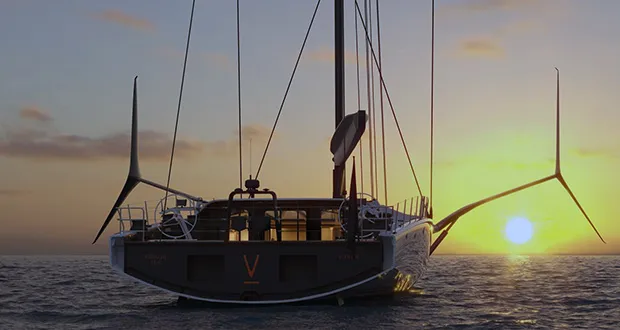
Raven is designed as a foil-assisted, ultra-lightweight superyacht and will be used primarily for day sailing while also being equipped to undertake high-speed, long-distance passages. First images reveal a curved, beak-like bow, two T-shaped foils and an eight-metre-long tubular bowsprit. She has been described as “one of the most extreme yachts [Baltic Yachts] has ever built,” by the shipyard.
Weight saving was central to the yacht’s design and she has been custom built with the lightest possible carbon and Nomex combination. Naval architecture and engineering are owed to Botin Partners and PURE Design respectively, who have both designed for the America’s Cup, with the overall design concept by Jarkko Jämsen.
Her stability and lift come from two large T-shaped hydrofoils mounted on hydraulically controlled side arms, capable of supporting some of the boat’s displacement. With a target displacement of 55 tons, Raven marks an ambitious next step for the shipyard, with their recent launch Zemi displacing 95 tons.
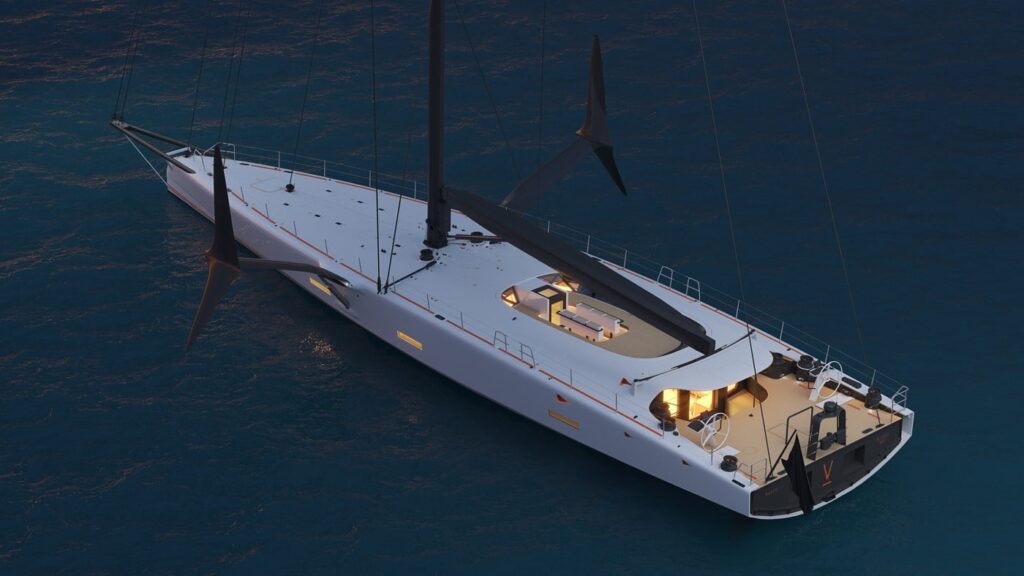
Key to her design is an unusual cockpit structure likened to that of a bird’s nest with Perspex set in crisscrossed carbon-composite mullions that creates an inverted observation dome. Further weight saving is achieved by minimising the amount of caulking between each pane and replacing some of it with a foam fillet. The cockpit is also able to convert to a semi-covered, hardtop seating area, courtesy of the clam-shell style forward section.
Despite her unconventional form, Raven’s rig and sail plan is similar to that of a conventional performance maxi with a single Southern Spars carbon mast and a suite of North Sails 3Di sails. Particular attention was given to the mainsail sheet track because Raven will be sailing most of the time with a wind angle forward of the beam. As a result, she sails not unlike a multihull with the main sail almost permanently sheeted home and trim adjustments made by moving the mainsheet car along its track.
Accommodation will be for four guests across two cabins, plus an owner’s cabin aft that includes a large double centreline berth that folds up against the interior bulkhead when racing. Jarkko Jämsén opted for a distinctive, industrial aesthetic for the interiors, featuring minimalist, but most importantly lightweight, rattan deckhands alongside exposed carbon.
Raven’s economical design extends even to the shower doors, which have been reduced from 13.5kg-per-metres-square to just 2.3kg-per-metres-square. To this same end, some custom parts have been 3D-printed in-house, including the clips which hold the carbon tubular accommodation framework in place.
“ Raven doesn’t fall easily into a category, but if I had to place her, I’d say she’s the equivalent of a high-end supercar,” said project manager Garth Brewer of A2B Marine Projects. “The boat is primarily for pure enjoyment and the owner likes the challenge of doing something that hasn’t been done before.”
Raven will be powered by twin Yanmar generators and a Swiss Phi-Power AG electric propulsion motor. The drive train is completed by a retractable propeller designed with carbon blades and a titanium hub.
Full specifications on speed and range have not yet been disclosed.
- Baltic Yachts
- Foil-Assisted
RELATED ARTICLES
Infiniti yachts and mcconaghy boats unveil the 32m sailing yacht infiniti 105, nauta design sheds light on the first southern wind sw108 gelliceaux design, baltic 68 café racer, vitters’ 59m sailing yacht maximus gears up for sea trials, an exclusive glimpse inside perini navi’s artexplore.

Subscribe to our newsletter
To be updated with all the latest news, offers and special announcements.
LATEST ARTICLES
A sweltering sunday: light winds and looming storms on the red sea, sailgp’s christchurch return: race times and maps revealed as excitement grows, alinghi red bull racing embracing the spirit of dedication, editor picks, canadian beau lake introduces the tahoe ’14 and lugano ’14 electric runabouts, underwater adventure and exploration with deepflight’s super falcon 3s, driving performance on land and on water: 41′ amg carbon edition, popular posts, young designer of the year 2022: ioana valentina corcodel reveals 65m ophelia concept, mirabaud sailing video of the century: celebrating 2 decades of passion, superyacht the flying fox seized in the dominican republic, popular category.
- Regatta 805
- America's Cup 380
- Motor Yachts 260
- Boating 215
- Superyachts 181
- Sailing 176
- Yachts News 173
- Sailing Yachts 162

Canova – The foiling superyacht designed for comfort
- Toby Hodges
- April 27, 2021
Not only the first foiling superyacht - or foil-assisted superyacht, but the first cruising yacht with a foil, the 142ft Canova is a groundbreaking project in so many ways, says Toby Hodges

Were you to somehow be teleported into foiling superyacht , Canova ’s palatial master cabin while under way – and let’s face it, many of us would like a sudden change of scene these days – you could be forgiven for thinking her owner doesn’t much like sailing.
For starters, it would seem remarkably quiet, thanks to the impressive insulation and a quiet ship system that ensures no unnecessary mechanical noise.
Then consider how surprisingly flat it feels for a monohull under sail, and not just because the generous berth you’re sitting on can gimbal.
However, once you look out of the considerable porthole, see the blue sea streaking past at over 20 knots and notice the orange plank of carbon fibre sticking out to leeward – which is serving to keep the boat a lot more upright than it should otherwise be – you’ll understand you’re actually aboard a truly state-of-the-art superyacht.

Lines and proportions are superb, hence it’s hard to gauge Canova’s size, and her long deckhouse blends in well. Photo: Baltic/Carlo Borlenghi
Anyone studying these pictures of Canova ripping along will quickly realise just how forward-thinking its owner is and how much he actually must enjoy sailing. Indeed, it can be argued that this yacht represents the present and future of cruising at speed and in utmost comfort.
Superyacht of the year
The 142ft/43m Farr design, launched from Baltic Yachts in October 2019, was conceived to be a powerful yet easily handled bluewater cruiser, capable of operating for long periods without specialist assistance.
It was commissioned by a serial yacht owner, who was also keen to minimise emissions by using hydro-generating electric propulsion. Canova was crowned sailing superyacht of the year winner 2020 at the World Superyacht Awards, with the jury commenting that it will “influence the future of sailing superyachts”.
Although this yacht teems with advanced technology throughout, you’ll notice little of it on boarding. You probably won’t even see the foil protruding while the boat is in port. The marvels of engineering have all been hidden behind a wonderfully luxurious cruising layout. Canova is a carbon epoxy wolf dressed in the finest lambswool clothing.

Demonstrating the foil, which retracts to the beam width of the boat. Photo: Baltic/Carlo Borlenghi
I was given a tour of the boat by her captain, Mattia Belleri, who project-managed the design and build over four years. I made the presumably common mistake of thinking Canova would be all about the foil, and while there are many integrated parts to that technological feat alone, I soon came to realise that the boat is full of innovative engineering, all aimed at creating a fast yet comfortable voyager.
Take the elegant, long and low deckhouse design for example, with its acreage of dimmable glass, which affords guests full protection and one-level living comfort.
Then there’s the inventive double deck design forward, which helps create room for a vast sail locker in which drums are stored for the furling foresails. And consider the diesel electric pod drive, which rotates to generate power while sailing.
Article continues below…

Inside the Infiniti 46 – video tour of the world’s first production offshore racer with DSS foils
Though most of us are captivated by the images of flying boats from International Moths to America’s Cup catamarans, the…

ClubSwan 36 review: This one-design foiler from Nautor really shakes things up
It’s easy to be seduced by modern high performance, especially downwind. As the wake flattens out astern and the foils…
Canova employs the most sustainable tech the yard felt it could use to still ensure it would still sail safely round the world.
The design team is extensive, including Gurit and BAR Technologies, but a lot of credit is given to the owner for his initial and enduring vision. “Everything began in the summer of 2015, when the owner started this quest of merging new technologies, volumes conception and energetic efficiency into a yacht,” Belleri stresses.
Foiling superyacht, Trend or trailblazer?
But let’s first address the talking point feature of the boat: a foil on a cruising superyacht… really?
Let’s remember that when Canova was being designed, monohulls with foils were still only really discussed in cult circles. And while we’ve seen this scene explode in racing, to the point where a boat is boring if it doesn’t fly and miraculously challenge physics, we’ve yet to see any foils employed for cruising purposes at all.
To decide to go ahead and create a foiling superyacht shows serious confidence in the technology.
Hugh Welbourn’s Dynamic Stability Systems (DSS) foil design has proved itself on smaller boats including the Infiniti 46 and 36 over the last decade, and retrofits have been successfully made to existing race boats such as Wild Oats XI and Wild Joe.

Helm stations and sailing systems are concentrated around Canova’s raised andbeamy aft deck. Photo: Baltic/Carlo Borlenghi
The multi-million dollar question here, though, was always going to be whether such a system would work on a 150-tonne superyacht.
In theory, the foil, which protrudes 22ft/6.7m horizontally to leeward to add masses of lift, should create a paradigm shift in fast cruising comfort. It was predicted to reduce heel and help the boat reach in comfort at sustained high speeds.
In practice, during initial sea trials Baltic tested the DSS upwind in 20-24 knots of wind and found not only a VMG increase, but a heel reduction of 30%. “To put these numbers into context, it would take an extra 33,000kg in the keel bulb – the total displacement weight of an IOR maxi – to achieve the same heel reduction,” Baltic reported.
During Canova ’s passage across Biscay in winter, aftersales representative Sam Evans described the yacht as much easier to handle with the foil deployed, “as boatspeed averaged between 20 and 22 knots and topped out at 24 knots”.
The DSS foil has also produced a dramatic reduction in pitching motion – measured at 42% less during trials – an element with which the owner was particularly impressed. Gordon Kay of Infiniti Yachts, the company that markets DSS, describes it as “industry-changing comfort”.
Although it’s a significantly complex piece of engineering, Baltic wanted to make the casing and mechanism to move the foil as simple and reliable as possible. The Finnish yard constructed a full-sized dummy system before the foil itself was fashioned by ISOTOP to within 1mm tolerance tip to toe.
It is controlled using a system of rope pulleys led to a Harken captive winch and, remarkably, can be pulled in or out at up to 17 knots of boatspeed.
As Belleri demonstrates the system, pushing the button to make the fluorescent diving board extend silently outwards, he explains that they wanted length for maximum leverage, but that it had to be practical too, to allow other boats to moor alongside. The resulting appendage is the same length as Canova ’s beam, so although the foil doesn’t retract fully, it meets a straight line to the top of the topsides.

Myriad push-button controls, including for two sets of deflectors, helps allow short-handed control of a powerful yacht. Photo: Baltic/Carlo Borlenghi
After a season spent mainly in the Tyrrhenian, especially in the breezy area between Sardinia and Corsica, Belleri tells me Canova has clocked over 25 knots, “and reaches the early 20s fairly quickly”. He also thinks her light wind performance is incredible: “she can sail at 14 knots in 9 knots of breeze.” “She’s fast, stable, silent and always ready to thrill,” he enthuses. “The foil was aimed primarily at comfort, motion dampening and reduced heeling and it is impressive to see how easily all these points are achieved at the push of a button.”
More retractable appendages
Advanced engineering is employed below the waterline too, in the form of a lifting keel with trim tab and an electrically-powered propeller leg. The latter rotates 170° each way to greatly ease manoeuvring. When sailing, water flow can turn the prop to generate energy and charge the lithium battery bank.
Belleri reports that the regeneration numbers go beyond expectations: “We have been generating many times more energy than required to sustain the yacht’s operational consumption.
Imagine sailing along at high speeds in full comfort, with no noise, no gases and no pollution, in a zero emissions energy balance. It is incredible and a must-try experience.”
Baltic predicts that Canova is able to sail across the Atlantic “using all her systems without recourse to conventional charging using an internal combustion engine”. The composite specialist also points out that the yacht was always devised around bluewater cruising, which means being independent of specialist support.
This includes the ability for it to be serviced without being lifted out. Canova can take her own weight sitting on her lifting keel in the raised position and the skipper told me they also wanted to be able to sail with the keel up in shallow waters. A super duplex stainless steel fin was constructed, with the keel mechanism itself made by APM in Italy.
Hiding the sails
At first glance, the rig may appear relatively conventional. The carbon Rondal mast and boom has electric in-boom furling and Carbolink rigging. A 3.5m batten supports the head of the huge square-top main, which can pass between the flying backstays once reefed.
The closer you look, the more you start to understand that the rig set-up is a clever one for power cruising once sails are unfurled.

The 7m guest tender carries a 1,000lt bladder for fuel bunkering and is housed under the flush foredeck. The 4.6m crew tender stows aft. Photo: Baltic/Carlo Borlenghi
The mast is stepped only slightly forward of the keel trunk, which leaves a large foretriangle area with tack points on deck for storm jib, staysail, self-tacking jib, code and asymmetric sails.
The really neat part is how this canvas stows. The three furling code and asymmetric sails use underdeck drum stowage, all housed in a gargantuan sail locker. The two drums act like giant fire hose reels. “They allow us to hoist and drop the heavy [400kg] furling sails safely, using minimal crew,” Belleri explains.
“I wanted furling sails that were easy to manage,” the skipper continues. The idea is that six permanent crew can run and actively sail the boat around the world and can manage a big (1,200m2) gennaker downwind. The sail options also include a quadrilateral, twin-clewed headsail, developed with Infiniti Yachts to complement the DSS system, which has found favour with the crew for its wide performance range.
The foredeck is kept particularly clean thanks to the intelligent design of hiding a second deck below. This keeps mooring equipment, including capstans, cleats and warps, all away from view yet accessible. The captive winches are also contained here, all built in carbon, which equates to a reported 200kg weight saving on each of the eight winches.
A large portion of the space below the foredeck is reserved for the guest tender. A crane mounts on deck to lift the 1.5 tonne limo into the water. The 7m length of this boat was one of the driving forces for the yacht’s overall dimensions, as the guest tender is also equipped with a 1,000lt bladder to allow for fuel bunkering in remote locations.
This also means there’s a proper watertight bulkhead aft instead of a traditional garage. Instead, the 4.6m crew tender stores in the lazarette under the aft deck. The aft deck itself is high enough to give clear visibility from the two outboard pedestals over the deckhouse and forward. “The idea was to be able to see the jib furler from the helms,” says Belleri.
Influential design
The design and construction of the deckhouse is another standout feature that should influence the design of large cruising yachts in the future. Why? Because of how well it blends into the lines, how much comfort it affords guests, and how well-finished it is for what is a seriously complex piece of engineering.
The guest cockpit, which is fully-protected by the hard bimini extending from the superstructure, is on the same level as the decksaloon. It means the guests have an amazing amount of protected space to enjoy their surroundings with almost unhindered views.
The whole aft section of the roof is freestanding and incorporates side windows that drop down at the push of a button to let fresh air into the guest cockpit.
Dimmable glass is used on the coachroof windows and skylights, all highly UV-protective to spare the interior woodwork. Made by Vision Systems, the dimming level of each window is adjustable.

Electric windows can be lowered to increase fresh air in the guest cockpit. Photo: Baltic/Carlo Borlenghi
As well as incorporating all this glass, the structure and its central supporting bulkhead has to take the 24-tonne loads of the mainsheet track. The traveller stretches over the beam of the roof, which helps keep loaded sheets away from the guest area.
The styling by Lucio Micheletti here – and throughout the interior – is particularly tasteful. It is peaceful and in harmony with the design. The majority of the finish is in teak timber veneers and white panelling, making natural light the star of the show.
Canova ’s general accommodation plan is formidable for cruising purposes. The guest accommodation is all forward of the saloon and central bulkhead. The presumption when you walk into the forward cabin is that this must be the owner’s suite – it certainly feels large and luxurious enough.
This makes for a particularly pleasant surprise then when you find the real deal beneath the deck saloon – in the most sensible, central section of the yacht, which boasts the greatest beam with the least pitching.

The owner’s full-beam suite is located almost amidships where there is least motion. Photo: Baltic/Carlo Borlenghi
The owner’s 65m2 apartment features a gimballing island berth, the largest bathroom or ‘spa’ you could imagine on a sailing yacht, including sauna and carbon fibre bath tub, plus his and hers/walk in wardrobes and washbasin areas. The owners spend a lot of time aboard so the idea was to provide the most comfortable facilities possible.
The crew area is all located abaft the saloon, with a central galley and private access from the aft deck. It’s an excellent design for ensuring privacy between guests and crew, while providing the accessibility serving staff need.

His and hers changing and bathroom areas in the master cabin. Photo: Baltic/Carlo Borlenghi
The day heads and entrance to the engine room are at the foot of the companionway to the saloon. The bank of programmable logic controllers in the control room should warn you that this is no ordinary engine room.
An electric heart
The machinery room proper houses the remarkably compact 420kW propulsion motor, two custom 210kW Cummins generators and six banks of Alkasol lithium-ion batteries.
The benefits of choosing this electric-hybrid route over conventional diesels include less vibration, noise, smell, maintenance, fewer running hours and a fraction of the oil required. And it is much more efficient, because the high-voltage charges are quicker and the gensets never run unnecessarily.
The 750V DC system is supplied by batteries, shorepower or generators. The generators were custom-built in carbon housings to optimise size, weight and performance and can charge the battery bank in two hours. The engineer shows me how everything is controlled from a Toughbook screen, flicking a genset on with the swipe of a finger. Canova can run silently at 9 knots with only one generator running.
I notice how comparatively cool it is in here. The engine room is strictly temperature controlled to a max of 31°C (as opposed to a more conventional 50°C or so). The battery bank and powerful inverters are water-cooled and the gensets have built-in ventilation extraction units.
It also feels alien to be able to talk rather than shout with a genset running. A lot of attention was paid to insulation, particularly as we are only one bulkhead away from the owner’s cabin (the 9m foil running under his berth encouraged the yard to focus intently on insulation). Mounting the batteries vertically also reportedly helps with damping.

Canova is all about mixing comfort with high technology. Micheletti’s styling reflects this technological clean design. Photo: Baltic/Carlo Borlenghi
With such a large battery and electrical capacity, the need for hydraulics is reduced, hence less weight and fewer space-hungry cables. The flexible energy system used means that power can be generated from multiple sources. The captive winches for instance draw energy, but when you sheet out they also create energy that can be tapped.
Belleri says the owner wanted the electric-hybrid technology from the outset, but that it needed to be safe and reliable for bluewater sailing. The environmental side was one of the big draws.
“Superyachting is not a green industry so we tried our best to go that way,” the skipper explains. “But it’s not fully possible without gensets yet.”
Instead he feels that the combination of electric engine, inverters, batteries and generators gives them plenty of redundancy power for cruising. COVID may have put their cruising temporarily on hold, but Canova ’s crew is still gearing up to start a circumnavigation later this year.
Fast forward
We often see technology trickle down from the racing or superyacht sides of sailing, where the large budgets and thirst for technology abound.
Many of the big ideas employed on Canova have been around for some years, including DSS foils and the regenerating drive system. But it takes a bold project (and owner) such as this to integrate them practically before people really take notice.
Canova is like a giant Swiss Army knife: it has so many useful features it can pull out, which stow away to leave a graceful profile. I would go so far as to say the sheer quantity of intelligent design incorporated makes this as innovative a project as we’ve seen to date in the superyachting world.
It is actively using technology, design and engineering that may have a telling effect not only on sailing superyachts, but on many cruising yachts to come. Given a choice, Canova is certainly the boat I would choose to be beamed aboard right now.
If you enjoyed this….
Yachting World is the world’s leading magazine for bluewater cruisers and offshore sailors. Every month we have inspirational adventures and practical features to help you realise your sailing dreams. Build your knowledge with a subscription delivered to your door. See our latest offers and save at least 30% off the cover price.

By SuperyachtNews 01 Oct 2020
SPONSORED CONTENT
Foil-assisted cruising by Baltic Yachts
The innovative dynamic stability system offers major benefits for the large cruising yacht sector….
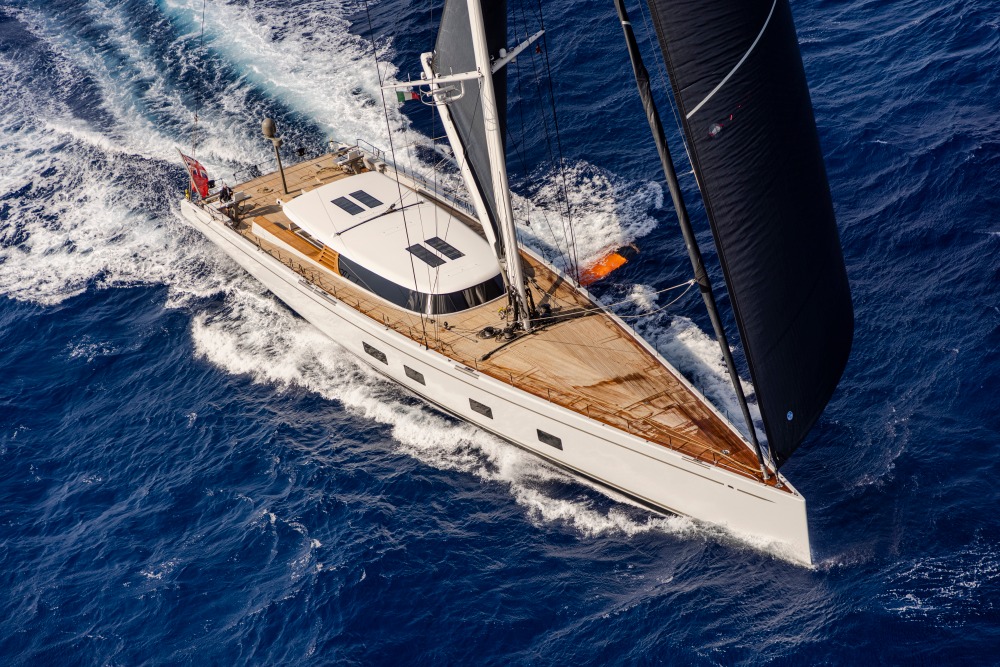
First adopted a decade ago by small racing yachts and, more recently, making the headlines as a key feature on board the latest America’s Cup boats, foil technology is typically associated with high-performance and high-speed sailing. However, Baltic Yachts ’ adoption of the innovative Dynamic Stability System (DSS) from Infiniti Yachts is changing this out-dated perception and proving that the foil technology offers major benefits for the cruising sector. As testament to this, the recently-delivered Baltic 142 Canova is the largest DSS foil-assisted yacht ever built, with the main aim of the technology being to improve on-board comfort as well as performance.
“The average cruising sailor might dismiss a foil as complex technology that makes the boat more difficult to handle with increases in speed and sensitivity, but this is not the case at all,” explains Henry Hawkins, executive vice president at Baltic Yachts. “The deployment of the DSS foil within a cruising environment actually stabilises the boat, making sail handling and control of the boat easier and safer. One of the key benefits is the reduction in heel angle and pitching, which dramatically increases comfort levels for those on board. There are also significant performance gains to be achieved, but this is not necessarily the primary focus for employing the DSS foil on cruising yachts and certainly wasn’t on Canova .”
While the development of the Infiniti-designed DSS foil has been an engineering feat for Baltic Yachts, working in conjunction with partners Farr Yacht Design, ISOTOP and BAR, the system has been simplified to make it as bulletproof as possible. “We wanted to ensure that something so apparently complex was made as simple and reliable as possible,” adds Roland Kasslin, head of research and development at Baltic Yachts. The system comprises a retractable foil built into the yacht just above the waterline. As the wind increases, the yacht heels and the foil is projected underwater to leeward, counteracting the heeling force and creating lift so that the yacht sails more upright.
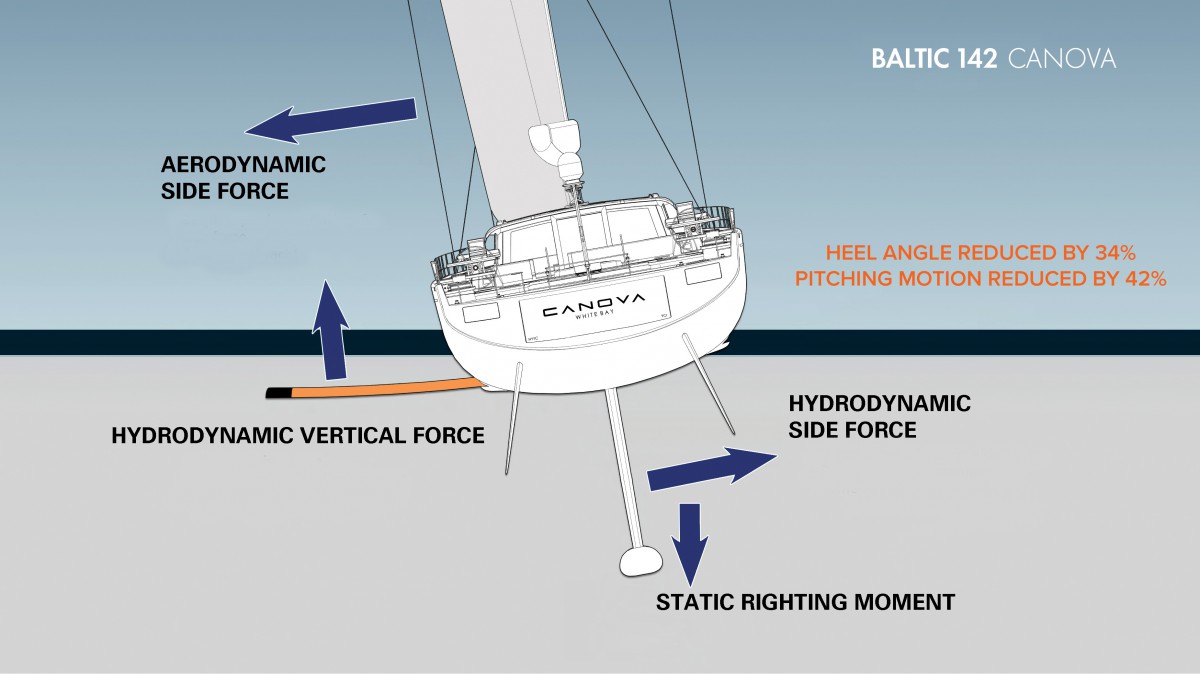
As a result, Baltic 142 Canova is proving to be more comfortable than any comparable sailing yacht. The DSS foil package has seen reduced heel angles of between eight to 10 degrees, as well as significant pitch and heave damping, both of which dramatically enhance comfort for those on board and reduce motion and strain on the helmsman. During Canova ’s first long-distance passage, the yacht crossed the Bay of Biscay in 50-plus knots of wind and big seas, but the deployment of the foil made the passage comfortable for all on board.
“For inexperienced sailors, heel angle is one of the aspects about large sailing yachts that people fear the most and can make life on board untenable – a heel angle of 18-plus degrees on a 43m yacht with a 9m beam creates a considerable sloping deck,” says Hawkins. “This significant reduction in heel angle means that moving around the boat is much easier and safer, making long passages more enjoyable.”
“This significant reduction in heel angle means that moving around the boat is much easier and safer, making long passages more enjoyable...”
Another benefit of the additional stability that the DSS foil provides is that less keel weight is required, which has the knock-on advantages of less required sail area, draught and overall displacement. Therefore, a lightweight hull in carbon composites ideally suits the system – Canova displaces just over 145 tonnes lightship. For this reason, it is important that the decision to include a DSS foil is made right at the beginning of a project, as retrofitting the system is not always the optimal solution.
While Canova is the largest yacht to be fitted with a foil by a significant amount, the scope of the DSS is boundless. “The technology is scalable as long as there is the technical space for it, and the bigger the boat, the more possibility there is for that,” advises Kasslin. “It would also be a weight-conscious decision: if you are deploying a foil then the boat needs to be able to achieve a certain speed in order to overcome the natural drag that the foil will produce.”
Thanks to its outside partners and, crucially, one brave and forward-looking client, Baltic Yachts has pushed the boundaries of foil technology and proven its benefits to the superyacht industry. The industry is naturally cautious towards innovation, and therefore adoption of foil-assisted cruising has taken time. However, the success of the DSS foil on board Canova is changing attitudes and, combined with the increasing use of foils on racing yachts, the technology is set to become more popular in the cruising sector, with Baltic Yachts paving the way.
Profile links
Baltic Yachts

Join the discussion
To post comments please Sign in or Register
When commenting please follow our house rules
Click here to become part of The Superyacht Group community, and join us in our mission to make this industry accessible to all, and prosperous for the long-term. We are offering access to the superyacht industry’s most comprehensive and longstanding archive of business-critical information, as well as a comprehensive, real-time superyacht fleet database, for just £10 per month, because we are One Industry with One Mission. Sign up here .
Related news
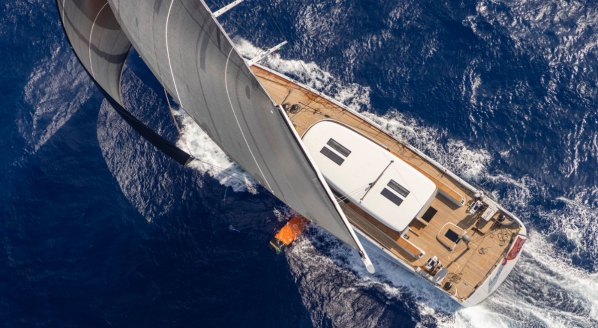
Baltic 142 Canova: pushing the boundaries of sailing
An update on how the largest sailing yacht to feature foil technology is performing
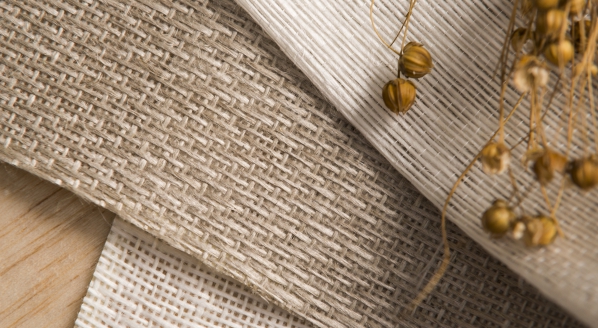
Flax: a sustainable alternative to carbon
Baltic Yachts has recognised the benefits of using flax as an alternative to carbon fibre in yacht construction
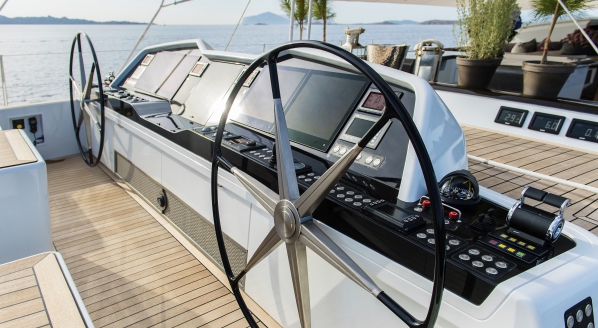
Baltic Yachts: bringing the true feeling of sailing to superyachts
Baltic Yachts discusses the development of its innovative force feedback system, which puts feeling back into the helm
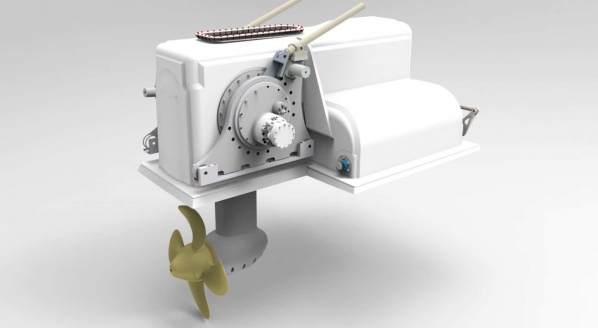
Propulsion for performance
SuperyachtNews speaks to Baltic Yachts about its innovative retractable propulsion system
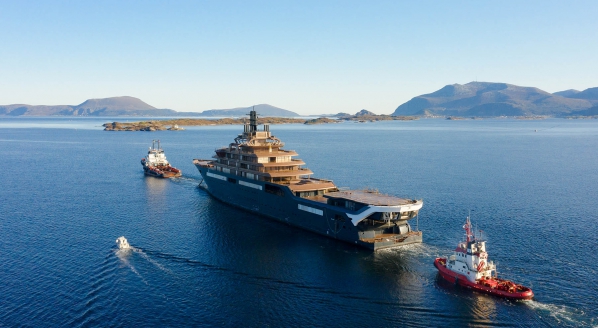
The Scandinavian superyacht market
A succinct summary of new build and cruising activity in the region
4 years ago
Sign up to the SuperyachtNews Bulletin
Receive unrivalled market intelligence, weekly headlines and the most relevant and insightful journalism directly to your inbox.
Sign up to the SuperyachtNews Bulletin
The superyachtnews app.

Follow us on
Media Pack Request
Please select exactly what you would like to receive from us by ticking the boxes below:
SuperyachtNews.com
Register to comment

The global authority in superyachting
- NEWSLETTERS
- Yachts Home
- The Superyacht Directory
- Yacht Reports
- Brokerage News
- The largest yachts in the world
- The Register
- Yacht Advice
- Yacht Design
- 12m to 24m yachts
- Monaco Yacht Show
- Builder Directory
- Designer Directory
- Interior Design Directory
- Naval Architect Directory
- Yachts for sale home
- Motor yachts
- Sailing yachts
- Explorer yachts
- Classic yachts
- Sale Broker Directory
- Charter Home
- Yachts for Charter
- Charter Destinations
- Charter Broker Directory
- Destinations Home
- Mediterranean
- South Pacific
- Rest of the World
- Boat Life Home
- Owners' Experiences
- Interiors Suppliers
- Owners' Club
- Captains' Club
- BOAT Showcase
- Boat Presents
- Events Home
- World Superyacht Awards
- Superyacht Design Festival
- Design and Innovation Awards
- Young Designer of the Year Award
- Artistry and Craft Awards
- Explorer Yachts Summit
- Ocean Talks
- The Ocean Awards
- BOAT Connect
- Between the bays
- Golf Invitational
- Boat Pro Home
- Pricing Plan
- Superyacht Insight
- Product Features
- Premium Content
- Testimonials
- Global Order Book
- Tenders & Equipment

Inside the Baltic 142 Foiling Superyacht Canova
Finnish yard Baltic Yachts has released first-look images inside its recently delivered 43.3 metre Baltic 142 Custom sailing yacht Canova.
The yacht was delivered following the completion of successful sea trials off the coast of Finland on October 20.
The yard said the Lucio Micheletti-designed interior had recently received its "finishing touches" and described it as "a study in understated interior design with white bulkhead panelling and deckheads combining with teak timber veneers."
It comes after the yard put the innovative DSS foiling technology through its paces during sea trials. Baltic released a video showing the nine metre "long sliding foil" in action and reported a good performance under sail.
"As the speed increases, the heel angle of the yacht reduces, no other system can do this. When the foil is deployed it extends 22ft (6.5m) to leeward," it said.
The yard also reported testing the foil upwind in winds of 20-25 knots, which "proved itself faster and with much less heel".
Canova , a sloop-rigged performance cruising yacht, features naval architecture and exterior styling by Farr Yacht Design while Lucio Micheletti collaborated with the in-house team at Baltic Yachts on the interior styling.
Canova stands out for being the first yacht of her size to be fitted with the DSS foil, which is designed to improve comfort and performance capabilities.
Canova features this innovative use of sailing technology, specifically its dynamic stability system. Developed in collaboration with Gordon Kay from Infiniti Performance Yachts, the system employs a sliding foil that can extend up to nine metres. This feature has featured on smaller yachts, but this is the first time it will be employed on a large sailing superyacht .
The foil has been designed to be deployed when the yacht is sailing at speed. The estimated result is a top speed increase of 5 to 20 per cent, depending on the conditions. The foil runs directly beneath the owner's cabin amidships.
During Canova’s first sailing sea trials, the push-button deployment of the nine metre long foil was reported as being "faultless" and she showed a reduction in heel and pitching motion in stronger wind conditions.
Gordon Kay of Infiniti Yachts previously said, “Having installed DSS in dozens of yachts we can confidently say we have reached another level with the impeccable installation of the foil case in the Baltic 142 Canova”.
Vice president at Farr Yacht Design Britton Ward added: "The predicted performance numbers are remarkable with the boat able to comfortably achieve boat speeds equal to wind speed in moderate to strong conditions".
To make the most of her performance, Canova has an extremely powerful rig and sail plan. A squaretop mainsail with a 3.5m long horizontal batten pushes the mainsail area up to 570 square metres, and her Her J1 adds another 390 square metres. All sails are by North Sails, while her all-carbon rig is by Rondal. The latter utilises Carbo-Link standing rigging, which is specifically designed to handle the increased loads generated by the additional stability delivered by the DSS foil.
Accommodation is for up to eight guests split across four cabins including an amidships owner’s suite. A long Bimini hardtop will extend out from the coachroof over the cockpit, providing a shaded al fresco relaxation spot and powered windows that lower at the touch of a button will provide further shelter in this area.
Other key features include a diesel electric Visedo/Cummins propulsion system, nine metre beam and a lifting keel that can reduce the draught from 6.5 metres to 3.8 metres.
Also put to the test during the sea trials on Canova was her innovative diesel electric propulsion and hydro-generating system. Both have been proven to substantially reduce noise and vibration while she is under power. The yard has reported that "during motoring trials the electric propulsion system was barely audible aboard the yacht."
Canova can use her propeller as a hydro-generator via the electric motor, which then charges her six banks of Lithium ion batteries.
The compact and quiet 420kW electric motor is able to drive the 145-ton yacht at a speed of 14 knots via her rotating, forward-facing, pull propeller, says Mattia Belleri of fluidsailing, who has project managed the design and build of Canova for her owner.
“The preliminary numbers are promising and we are confident fine tuning will deliver the performance we are expecting," says Kim Kolam, Senior Electrical Engineer at Baltic Yachts.
More about this yacht
Similar yachts for sale, more stories, most popular, from our partners, sponsored listings.
Maps and Navigation
Getting around and planning your itinerary in Moscow

Bicycle and Scooter Rental
How to Rent Two-Wheeled Transport
You may be interested


- CLASSIFIEDS
- NEWSLETTERS
- SUBMIT NEWS

Baltic 111 Raven in a class of her own as she is prepared for launching
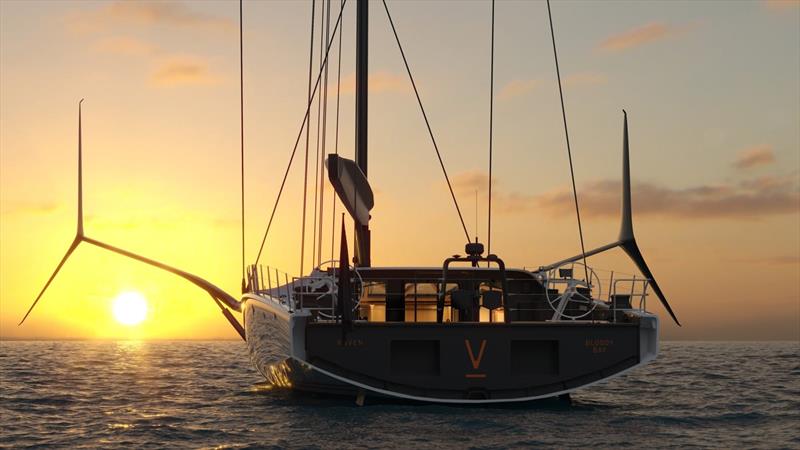
Related Articles
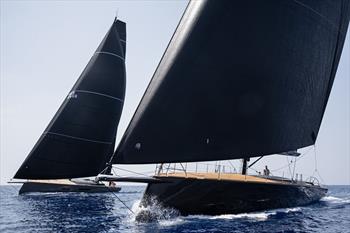

- Service & Refit
- Baltic Yachts Rendezvous
BALTIC YACHTS LIGHTER, STIFFER, FASTER, GREENER – TOGETHER
Baltic Yachts is the world’s leading builder of advanced composite yachts. Our highly skilled workforce uses leading edge marine technology and traditional craftsmanship to create award-winning yachts. Each yacht is unique, unmatched in its quality, unmatched in its performance.
Through our deep understanding of advanced composite materials like carbon fibre, we build luxury yachts, which are lighter, stiffer and faster than the competition. Controlling weight, maximising performance and using a rigid, precision-engineered structure provide the platform for the best possible sailing experience.
OUR UNIQUE YACHTS
Baltic Yachts has built an impressive and highly respected reputation for building a new breed of multi-role yachts performing to the highest standards both as luxury cruisers and successful racing yachts competing on the global superyacht regatta circuit.
Combining the latest carbon fibre engineering with top build quality from our skilled Finnish workforce, yachts like the Baltic 115 Nikata, the Baltic 130 My Song and the Baltic 175 Pink Gin are prize winning examples of how performance and luxury accommodation can be successfully combined in a modern yacht.
PASSION FOR INNOVATION
Our engineers, designers and craftsmen are constantly developing ideas and team up with external experts in their fields to turn what at first might seem an impossible dream into reality. Whether custom or semi-custom built, each yacht displays features reflecting the forward-thinking nature of our clients.
We pride ourselves in our innovative thinking and design to make our yachts easier, safer and more efficient. Whether it’s a performance-enhancing DSS foil, a retractable propeller or finger-light responsive steering, Baltic Yachts can deliver.
RECENT NEWS
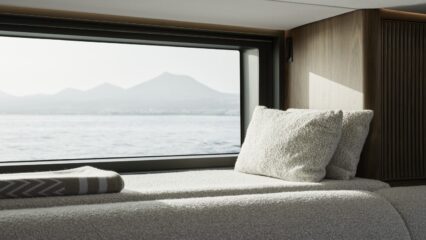
5 March 2024
Tide magazine: from land to sea.
Featuring a contemporary, warm and crafted look by Swedish architects Andreas Martin-Löf Arkitekter, the 34m sailing yacht ZEMI is a fine example of how shore-side designers can adapt to create stunning, boundary-pushing yacht interiors Forward-thinking shipyards and owners are becoming increasingly creative and inviting designers...

12 February 2024
Baltic yachts appoints new chief executive officer.
The world’s leading advanced composite yacht builder Baltic Yachts, Finland announces the appointment of new CEO, Tom von Bonsdorff, who joined the company on 5th February, 2024. With a successful background in management for Swedish automotive giant Volvo and more recently for Kesko, where he...

23 January 2024
Tide magazine: baltic yachts hits 50.
At the crest of boat-building since 1973, founder PG Johansson looks back at the making of Baltic Yachts Fifty years is a long time in anybody’s book, but doubly so in the gruelling world of boatbuilding. Simply in reaching its half-century, Finland’s Baltic Yachts is...
We’re constantly updating our website to bring you news of launchings, new commissions and Baltic inspired innovation.

IMAGES
COMMENTS
The 111ft Raven is the most extreme sailing yacht Baltic Yachts has built, exceeding even the likes of Baltic 147 Visione and Baltic 197 Hetairos. She is the first superyacht in the world to use foiling technology in this way, has undergone one of the most intense weight-saving exercises her builder has ever completed, yet is fitted out with a ...
Giant T-foils provide most of the stability for Baltic 111 Raven, a cruising yacht that's likely to break speed records with its hydrofoils born of America's Cup technology. Wow…! This foil ...
Baltic Yachts has successfully moved the Baltic 111 Raven from her building facility at the company's waterside premises in Jakobstad, Finland to reveal one of the most extreme yachts it has ever built. Broadly described as a 111ft foil-assisted, ultra-lightweight superyacht, she will be used primarily for day sailing, but also undertake high ...
Ultra-lightweight interior of Baltic 111 Raven. Not only is Raven's foil-assisted ability likely to deliver a phenomenal sailing performance, she is also the subject of a highly unusual study in ultra-lightweight interior design, combining the yacht's complex all carbon construction with styling which pays homage to Baltic Yachts' rigorous program of weight saving.
Raven is designed as a foil-assisted, ultra-lightweight superyacht and will be used primarily for day sailing while also being equipped to undertake high-speed, long-distance passages. Images reveal a curved, beak-like bow, two T-shaped foils and an eight-metre-long tubular bowsprit. She has been described as "one of the most extreme yachts [Baltic Yachts] has ever built," by the shipyard.
Baltic Yachts worked with a highly-skilled team assembled by designer Jarkko Jämsén, including in-demand Spanish race boat naval architects Botin Partners. Structural engineering by PURE Design and Engineering. ... Early sailing trials for the foil-assisted Baltic 111 Raven have been described as 'very successful' as the super-lightweight ...
Raven is designed as a foil-assisted, ultra-lightweight superyacht and will be used primarily for day sailing while also being equipped to undertake high-speed, long-distance passages.First images reveal a curved, beak-like bow, two T-shaped foils and an eight-metre-long tubular bowsprit. She has been described as "one of the most extreme yachts [Baltic Yachts] has ever built," by the ...
Baltic 111 Raven foiling trials completed. Early sailing trials for the foil-assisted Baltic 111 Raven have been described as 'very successful' as the super-lightweight sloop showed impressive reliability and reached sustained speeds in the high 20s during 10 consecutive days of sailing off Baltic Yachts' head-quarters in Jakobstad, Finland.
Baltic Yachts has officially launched the ultra-light, foil-assisted 111ft Raven in preparation for further sailing trials off Jakobstad in September, this time using her foils. The ground-breaking yacht was first lowered into the water in mid-July, using her single point lift, minus her side arms and T-shaped hydrofoils, so that…
Foil-assisted cruising is the latest innovation to emerge from Baltic Yachts. We talk to the team behind the Baltic 142 to find out how it works. The Baltic 142 may not be using the hydrofoils ...
Here is a first glimpse from the successful sea trials in Finland when Raven finally spread her wingsThe revolutionary superyacht, the first sailing yacht of...
Early sailing trials for the foil-assisted Baltic 111 Raven have been described as 'very successful' as the super-lightweight sloop showed impressive reliability and reached sustained speeds in the high 20s during 10 consecutive days of sailing off Baltic Yachts' head-quarters in Jakobstad, Finland
Not only the first foiling superyacht, but the first cruising yacht with a foil, the 142ft Canova is a groundbreaking project, says Toby Hodges ... The 142ft/43m Farr design, launched from Baltic ...
However, Baltic Yachts ' adoption of the innovative Dynamic Stability System (DSS) from Infiniti Yachts is changing this out-dated perception and proving that the foil technology offers major benefits for the cruising sector. As testament to this, the recently-delivered Baltic 142 Canova is the largest DSS foil-assisted yacht ever built, with ...
Inside the Baltic 142 Foiling Superyacht Canova. Finnish yard Baltic Yachts has released first-look images inside its recently delivered 43.3 metre Baltic 142 Custom sailing yacht Canova. The yacht was delivered following the completion of successful sea trials off the coast of Finland on October 20. The yard said the Lucio Micheletti-designed ...
Moscow is an oasis of green spaces. The city has more than 140 natural areas. According to World Atlas, 54 percent of Moscow's area are covered by public parks and gardens, so Moscow was ranked number one among the greenest cities in the world. The Flotilla consists of seven river yachts sailing along the Moskva River with designer ...
"SAFARI"/ "САФАРИ" — the BEST Hunting and Fishing magazine in Russia, CIS and Baltic states, the residence of 4 mln hunters and 18 mln fishermen - invites our visitors for cooperation. The magazine is devoted to international hunting and fishing , hunting and fishing tourism, trophy hunting, deep-sea and sport fishing, adventures ...
HOW IT WORKS. DSS works by using the forward motion of the yacht combined with a retractable foil to increase stability by creating lift. The DSS foil, set to leeward of the yacht and submerged in the water, creates this lift. As the wind increases, the yacht heels and accelerates resulting in the DSS foil producing extra lift to leeward ...
Baltic Travel is a travel agency specialising in holidays, guided tours, short breaks and city-breaks to The Baltics. We offer a wide range of holiday types to The Baltics +44 (0)208 233 2875. UK Local 08456 800 642. 1866 834 8359 1800 025 807. Search Try our Advanced Search. Home; Destinations. The Nordics; Norway; Greenland;
Ultra-lightweight interior. Not only is Raven's foil-assisted ability likely to deliver a phenomenal sailing performance, she is also the subject of a highly unusual study in ultra-lightweight interior design, combining the yacht's complex all carbon construction with styling which pays homage to Baltic Yachts' rigorous programme of weight saving.
First adopted a decade ago by small racing yachts and, more recently, making the headlines as a key feature on board the latest America's Cup boats, foil technology is typically associated with high-performance and high-speed sailing. However, Baltic Yachts' adoption of the innovative Dynamic Stability System (DSS) from Infiniti Yachts is changing this out-dated perception and proving that ...
Rome2Rio makes travelling from Moscow to Baltic Sea easy. Rome2Rio is a door-to-door travel information and booking engine, helping you get to and from any location in the world. Find all the transport options for your trip from Moscow to Baltic Sea right here. Rome2Rio displays up to date schedules, route maps, journey times and estimated ...
Baltic Yachts has built an impressive and highly respected reputation for building a new breed of multi-role yachts performing to the highest standards both as luxury cruisers and successful racing yachts competing on the global superyacht regatta circuit. ... safer and more efficient. Whether it's a performance-enhancing DSS foil, a ...